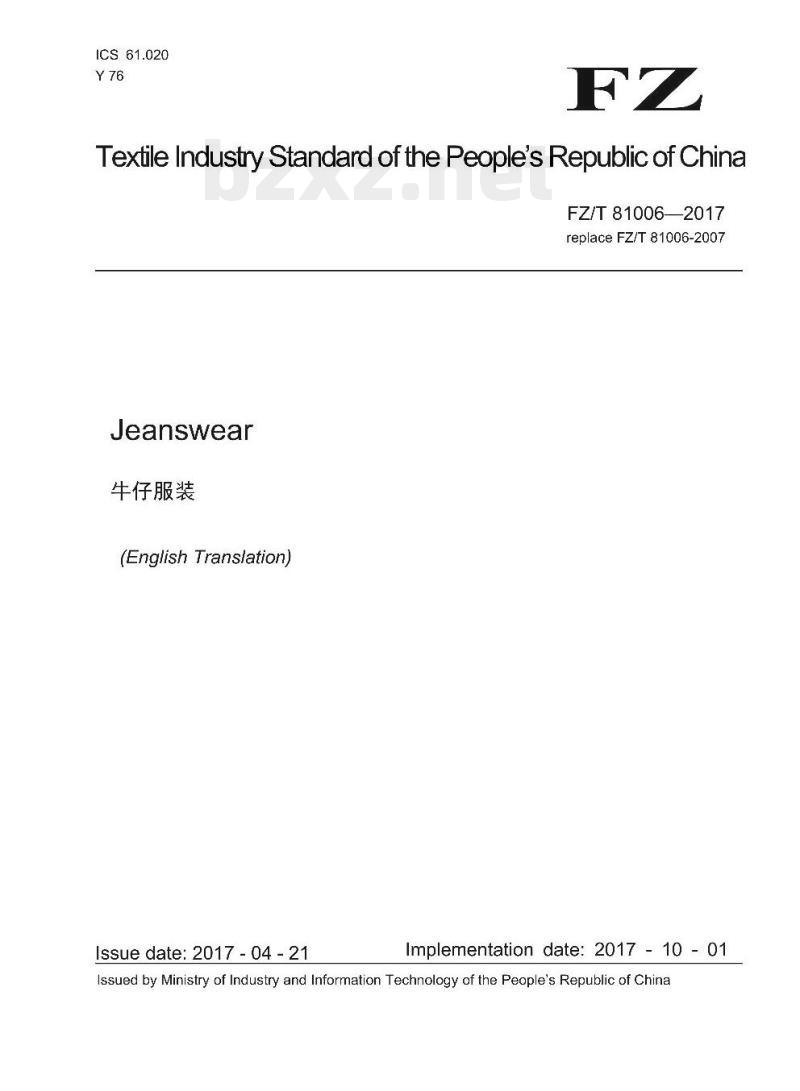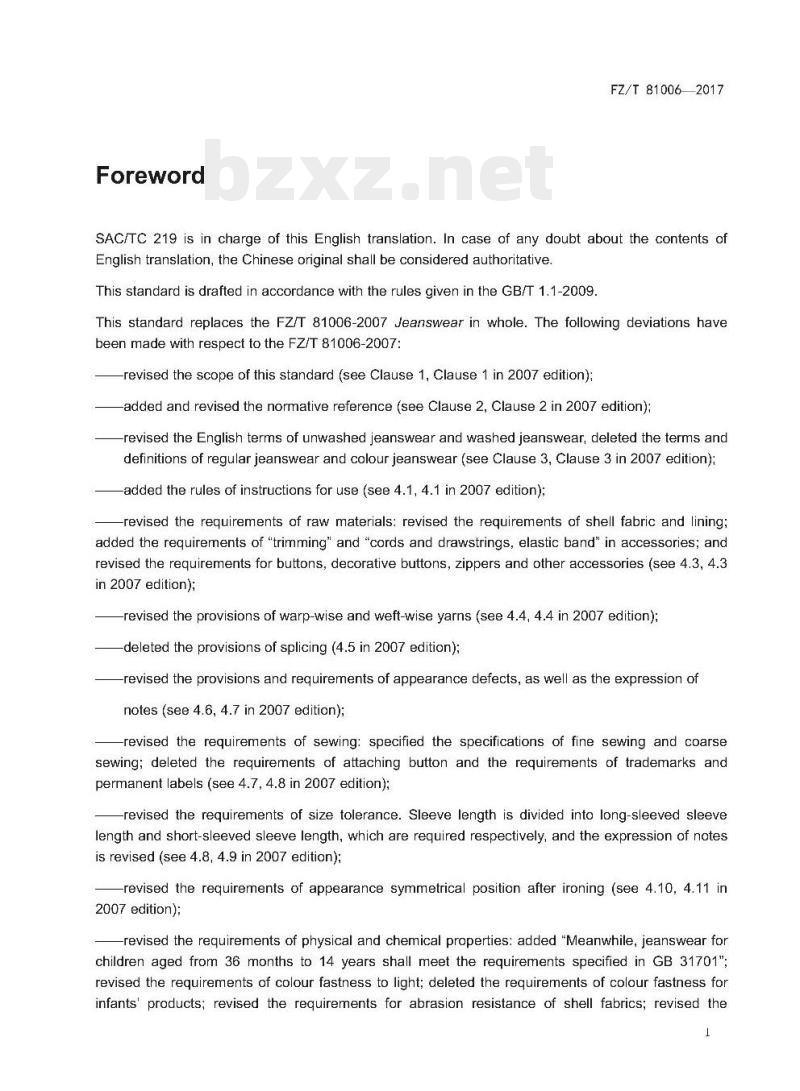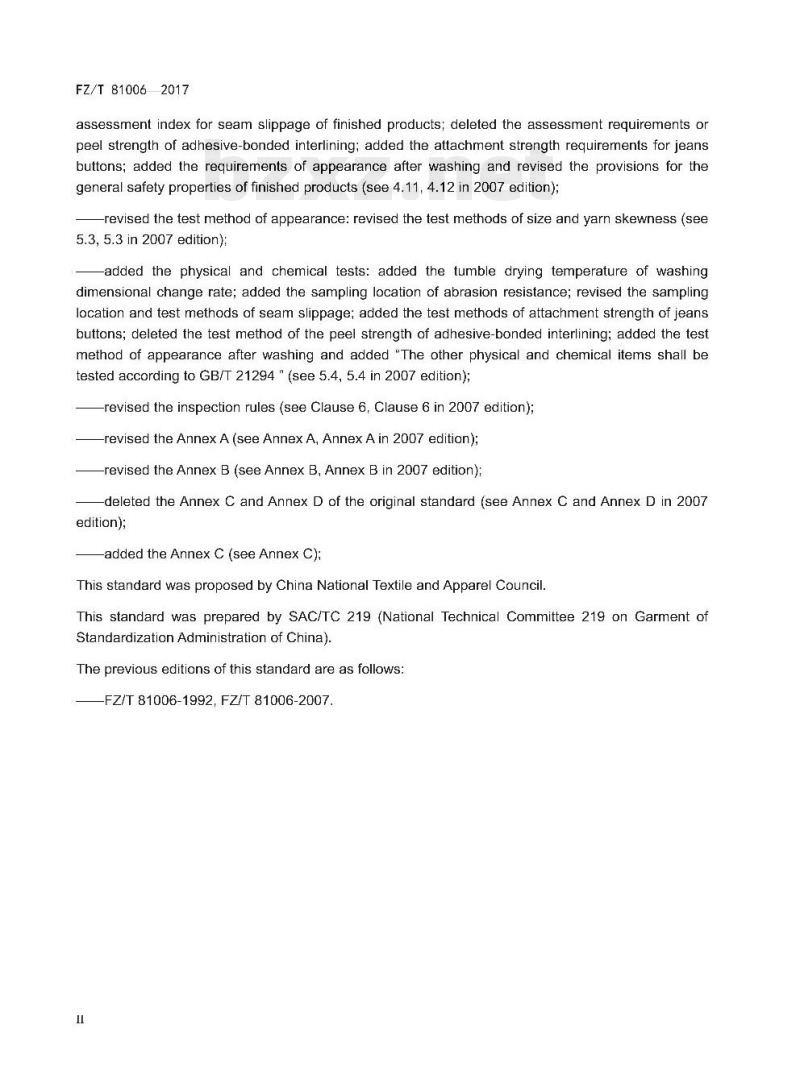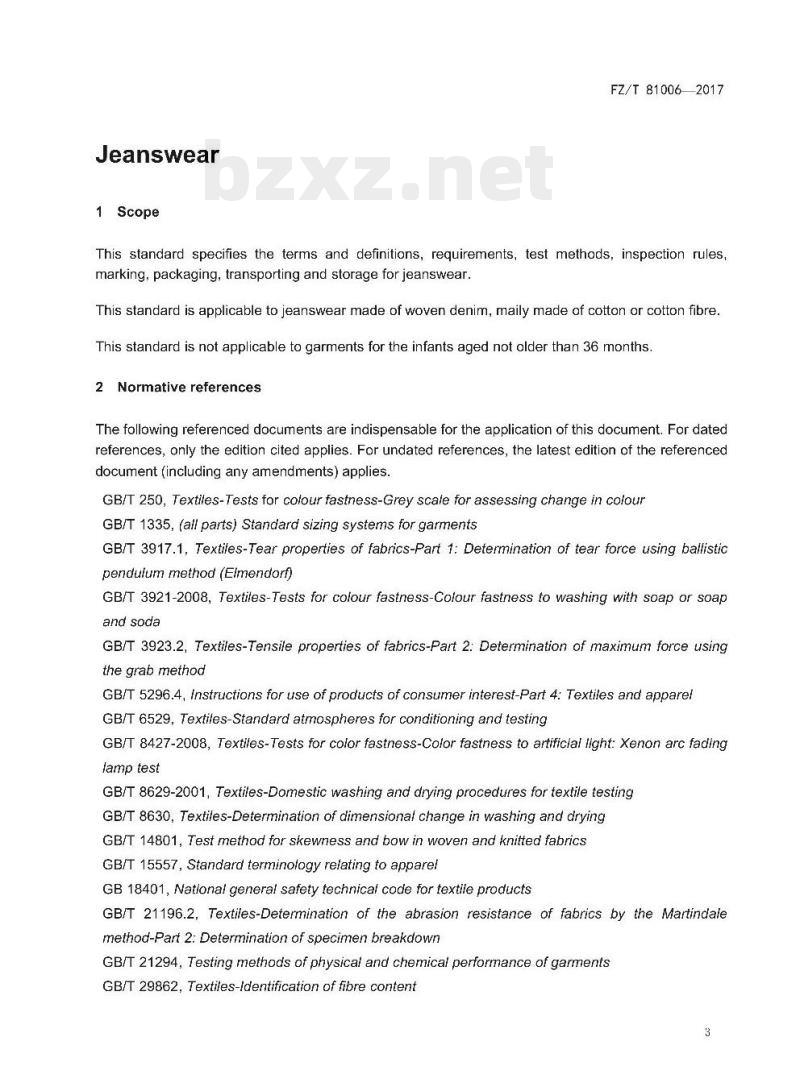- 您的位置:
- 标准下载网 >>
- 标准分类 >>
- 纺织行业标准(FZ) >>
- FZ/T 81006-2017 牛仔服装
标准号:
FZ/T 81006-2017
标准名称:
牛仔服装
标准类别:
纺织行业标准(FZ)
标准状态:
现行出版语种:
简体中文下载格式:
.zip .pdf下载大小:
8.07 MB
点击下载
标准简介:
FZ/T 81006-2017.
1范围
FZ/T 81006规定了牛仔服装的术语和定义、要求.检验方法、检验规则以及标志.包装、运输和贮存。
FZ/T 81006适用于以纯棉或棉纤维为主要原料的机织牛仔布生产的牛仔服装。
FZ/T 81006不适用于年龄在36个月及以下的婴幼儿服装.
2规范性引用文件
下列文件对于本文件的应用是必不可少的。凡是注8期的引用文件,仅注8期的版本适用于本文件。凡是不注日期的引用文件,其最新版本(包括所有的修改单)适用于本文件。
GB/T 250纺织品色牢度试验 评定变色用灰色样卡
GB/T 1335(所有部分)服装号型
GB/T 3917.1纺织品织物撕破性能 第1部分:冲击摆锤法撕破强力的测定
GB/T 3921- -2008纺织品色牢度试验 耐皂洗色牢度
GB/T 3923.2纺织品织物拉伸性能 第2部分;断裂强力的测定(抓样法)
GB 5296.4消 费品使用说明第4 部分:纺织晶和服装
GB/T 6529纺织晶调湿 和试验用标准大气
GB/T 8427- -2008 纺织品色牢度试验 耐人造光色牢度: 氙弧
GB/T 8629- -2001 纺织品试验用家庭 洗条和干燥程序
GB/T 8630纺织品洗涤和干燥后 尺寸变化的测定
GB/T 14801机织物 与针织物纬斜和弓纬试验方法
GB/T 15557服装术语
GB 18401国家纺织产 品基本安全技术规范
GB/T 21196.2纺织品马丁 代尔法织物耐磨性的测定第2部分:试样破损的测定
GB/T 21294服装 理化性能的检验方法
GB/T 29862纺织品纤维 含量的标识
GB 31701婴幼儿及儿童纺织产品安全技术规范
GB/T 31907服装测量方法
FZ/T 80002服装标志 、包装、运输和贮存
FZ/T 80004服装 成品出厂检验规则
3术语和定义
GB/T 15557确立的以及下列术语和定义适用于本文件。
3.1原色产品unwashed jeanswear
成品或所用面料只经退浆、防缩整理,未经洗涤方式加工整理的牛仔服装。
部分标准内容:
TextileIndustryStandardofthePeople'sRepublicofChinaFZ/T 810062017
replaceFz/T81006-2007
Jeanswear
牛仔服装
(EnglishTrans/ation)
Issuedate:2017-04-21
Implementationdate:2017-10-01Issued by Ministry of Industry and Information Technology of the People's Republic of ChinaForeword
FZ/T810062017
SAC/TC 219 is in charge of this English translation. In case of any doubt about the contents ofEnglish translation, the Chinese original shall be considered authoritative.This standard is drafted in accordance with the rules given in the GB/T 1.1-2009.This standard replaces the FZ/T 81006-2007 Jeanswear in whole. The following deviations havebeenmadewithrespecttotheFZ/T81006-2007:revised the scope of this standard (see Clause 1, Clause 1 in 2007 edition):-added and revised the normative reference (see Clause 2, Clause 2 in 2007 edition):-revised the English terms of unwashed jeanswear and washed jeanswear, deleted the terms anddefinitions of regular jeanswear and colour jeanswear (see Clause 3, Clause 3 in 2007 edition):-added the rules of instructions for use (see 4.1, 4.1 in 2007 edition);revised the requirements of raw materials: revised the requirements of shell fabric and liningadded the requirements of \trimming\ and \cords and drawstrings, elastic band\ in accessories; ancrevised the requirements for buttons, decorative buttons,zippers and other accessories (see 4.3, 4.3in2007edition)
-revised the provisions of warp-wise and weft-wise yarns (see 4.4, 4.4 in 2007 edition):-deleted the provisions of splicing (4.5 in 2007 edition):-revisedtheprovisionsandrequirementsofappearancedefects,aswell astheexpressionofnotes (see 4.6, 4.7 in 2007 edition):-revised the requirements of sewing: specified the specifications of fine sewing and coarsesewing; deleted the requirements of attaching button and the requirements of trademarks andpermanent labels (see 4.7, 4.8 in 2007 edition):-revised the requirements of size tolerance. Sleeve length is divided into long-sleeved sleevelength and short-sleeved sleeve length, which are required respectively, and the expression of notesis revised (see 4.8, 4.9 in 2007 edition):-revised the requirements of appearance symmetrical position after ironing (see 4.10, 4.11 in2007 edition);
revised the requirements of physical and chemical properties: added \Meanwhile, jeanswear forchildren aged from 36 months to 14 years shall meet the requirements specified in GB 31701\;revised the requirements of colour fastness to light; deleted the requirements of colour fastness forinfants products; revised the requirements for abrasion resistance of shell fabrics; revised theFZ/T810062017
assessment index for seam slippage of finished products; deleted the assessment requirements orpeel strength of adhesive-bonded interlining: added the attachment strength requirements for jeansbuttons; added the requirements of appearance after washing and revised the provisions for thegeneral safety properties of finished products (see 4.11, 4.12 in 2007 edition);-revised the test method of appearance: revised the test methods of size and yarn skewness (see5.3,5.3in2007edition):
added the physical and chemical tests: added the tumble drying temperature of washingdimensional change rate; added the sampling location of abrasion resistance; revised the samplinglocation and test methods of seam slippage; added the test methods of attachment strength of jeansbuttons; deleted the test method of the peel strength of adhesive-bonded interlining; added the testmethod of appearance after washing and added \The other physical and chemical items shall betested according to GB/T 21294 \ (see 5.4, 5.4 in 2007 edition);-revised the inspection rules (see Clause 6, Clause 6 in 2007 edition);-revised the Annex A (see Annex A, Annex A in 2007 edition);revised the Annex B (see Annex B, Annex B in 2007 edition):-deleted the Annex C and Annex D of the original standard (see Annex C and Annex D in 2007edition);
added the Annex C (see Annex C):This standard was proposed by China National Textile and Apparel Council.This standard was prepared by SAC/TC 219 (National Technical Committee 219 on Garment ofStandardization Administration of China)The previous editions of this standard are as follows:-FZ/T81006-1992,FZ/T81006-2007.1
Jeanswear
1Scope
FZ/T 810062017
This standard specifies the terms and definitions, requirements, test methods, inspection rules,marking, packaging, transporting and storage for jeanswear.This standard isapplicableto jeanswear made of woven denim,maily made of cotton or cotton fibre.This standard is not applicable to garments for the infants aged not older than 36 months.2Normativereferences
The following referenced documents are indispensable for the application of this document. For datedreferences, only the edition cited applies. For undated references, the latest edition of the referenceddocument (including any amendments) applies.GB/T250,Textiles-Testsforcolourfastness-GreyscaleforassessingchangeincolourGB/T1335,(allparts)Standard sizingsystemsforgarmentsGB/T 3917.1,Textiles-Tear properties of fabrics-Part1:Determination of tear force using ballisticpendulummethod (Eimendorf)
GB/T3921-2008,Textites-Testsfor colourfastness-Colour fastness towashing with soap orsoapandsoda
GB/T3923.2,Textiles-Tensilepropertiesoffabrics-Part2:Determinationof maximumforce usingthe grab method
GB/T 5296.4,instructions for use of products of consumer interest-Part4:Textiles and apparelGB/T6529,Textiles-StandardatmospheresforconditioningandtestingGB/T8427-2008,Textiles-Testsforcolorfastness-Colorfastnesstoartificial light:Xenonarcfadingfamptest
GB/T 8629-2001,Textiles-Domestic washing and drying procedures fortextile testingGB/T 8630, Textiles-Determination of dimensional change in washing and dryingGB/T 14801, Test method for skewness and bow in woven and knitted fabricsGB/T 15557, Standard terminology relating to apparelGB 18401, National general safety technical code for textile productsGB/T 21196.2, Textiles-Determination of the abrasion resistance of fabrics by the Martindalemethod-Part2:Determination of specimenbreakdownGB/T21294,TestingmethodsofphysicalandchemicaiperformanceofgarmentsGB/T29862,Textiles-IdentificationoffibrecontentFZ/T810062017
GB31701,SafetytechnicalcodeforinfantsandchildrentextileproductsGB/T 31907, Method of garment measurementFZ/T80002,Marking,packagingtransportationandstorageforgarmentsFZ/T 80004, Rule for garments delivery inspection3 Terms and definitions
For the purposes of this document, the terms and definitions in GB/T 15557 and the followings apply3.1Unwashedjeanswear
Finished products and fabrics processed by desizing, shrinkage control finishing but not by finishingofwashingprocess.
3.2Washedjeanswear
Finished products andfabricsprocessedbystonewash,enzymewash,bleachwash,orcombinations.
4 Requirements
4.1 Instructions for use
The instructions for use shall be in accordance with GB/T 5296.4 and GB 31701, and the productsshall be marked as washed jeanswear or unwashed jeanswear. The special processes such asspecialabrasion,damaged washing andetc.,shall be indicated inthe instructions4.2Sizesandspecifications
4.2.1The size shall be set according to GB/T 13354.2.2 The specification of the main parts of finished products shall be designed according to therelevantrequirementsofGB/T1335.4.3Raw materials
4.3.1 Shell fabrics
The shell fabrics shall be chosen in accordance with relevant national standards to meet the qualityreguirements specified in this standard4.3.2 Linings
The linings shall match with the shell fabrics and meet the quality requirements specified in thisstandard
4.3.3Accessories
4.3.3.1Interlinings,shoulderpads,trimminglacesandpocketclothFZ/T810062017
The Interlinings, shoulder pads, trimming laces and pocket cloth shall match the properties of bothshell fabrics and linings, and shall meet the quality requirements specified in this standard.4.3.3.2 Sewing threads, cords and drawstrings, elastic bandsThe sewing threads, cords and drawstrings, elastic bands (except for decorative threads and bands )shallmatchthepropertiesoftheshellfabrics,liningsandaccessories4.3.3.3Buttons,zippers and otherattachmentsThe buttons (except for decorative buttons), zippers and other attachments shall match the shellfabrics. The surface of buttons, zippers and other attachments shall be smooth and without burrs.damage, defects, accessible sharp points and/or sharp edges. The zipper shall be in mesh and bepulled smoothly.
Notes: The accessible sharp points and sharp edges mean that the product can hurt human skin under usual wearingconditions.Children'sgarmentsshall beinaccordancewiththerelevant provisionsof GB31701inaddition4.4Directionsofwarpandweftyarns4.4.1 The yarn skewness of front, back, sleeves and collar shall not be greater than 3%4.4.2The yarn skewness of trousers or skirts shall not be greater than 2%.4.5 Colour difference
4.5.1Unwashed jeanswear.Thecolourdifferenceatsleeves seam, sideseamand side seam of thetrousers shall not be lower than grade 4. The colour difference at other surface parts shall be greaterthan grade 4. The colour difference between top and bottom in one suit shall not be lower than grade3-4. The colour difference among finished products within the same lot shall not be lower than grade3-4.
4.5.2The colour difference isnotrequired forwashed jeanswear4.6Defects oftheappearance
The acceptable defects at each part of the finished product should comply with the requirements inTable 1. The parts division is shown in Figure 1. Only one defect is allowed on each individual part ofthe finished product. For the ones not listed in this standard, they can be determined according tosimilardefects listed inTable1asreference.5
FZ/T 810062017
Defects
Warpdefects
Weftdefects
Scattered defects
Damaging defects
Stains
Part 1下载标准就来标准下载网
Not allowed
Slight, shorter than 0.5 cm:one defect allowed
Not allowed
Notallowed
Nat allowed
Table1
Acceptabledefects for each partPart 2
Slight, shorter than 2.0 cm orsmallerthan 1.0 cm?; two
defects allowed
Slight, shorter than 2.0 cm orsmallerthan 1.0 cm?;two
defects allowec
Slight
Notallowed
Sharter than 2.0 cm or
smaller than 1.0 cm2: one
defect allowed
Slight, shorter than 3.0 cm orsmallerthan 1.0cm2;two
defects allowed
Slight, shorter than 3.0 cm orsmaller than 1.0 cm2; two
defects allowed
Slight
Notallowed
Shorter than 3.0 cm or
smaller than 1.0 cm2; two
defects allowed
Note 1: Damaging defects are not required for products marked for special finishing of abrasion or damaged washing,and etc.
Note2:Theexplanationfordefectsofappearance,seeAnnexA.Fig.1
4.7Sewing
Fig.1(continued)
FZ/T810062017
4.7.1 The stitch density shall conform to the requirements in Table 2, except for special designs.Table2
Slant stitches and blind stitchesOverlockstitches
Sewing buttonhole
Fine thread
Coarse thread
Stitch density
Not less than 8 stitches / 3 cmNotlessthan8stitches/3cm
Notless than8 stitches/1cm
Not less than 6 stitches / 1 cmNotes: Fine thread means the linear density of sewing thread should not be more than 2o tex. For coarse thread means the linear density of sewing thread should be over 20 tex.4.7.2The seam allowance of pockets and belt loops shall not be less than 0.6 cm.4.7.3 All the exposed seam allowance shall be hemmed or overlocked (except for special designs)4.7.4 All stitches shall be straight, neat, smooth and firm.4.7.5 Thread connection is not allowed within 20 cm of slant stitching lines. For slant stitching linesthatare over20 cm, one thread connection is allowed, but skipped stitches and threadbreakagewithin all slant stitching lines are not allowed.4.7.6 The trademarks and permanent labels shall be placed straight and flat.FZ/T 810062017
4.7.7 The position and size of buttonholes shall be suitable. The attachment strength of buttonsshall be enough. Thread breakage for buttons is not be allowed,4.7.8The decorations such as embroidery or embedding shall be firm and flat.4.8 Tolerance of size and specificationThe tolerances of sizes and specifications for main parts of finished products shall conform to therequirements in Table 3.
Table3
Tolerances of sizes and specificationsUnwashed jeanswear
Length of tops
Chest girth
Collar length
Shoulder width
Long-sleeve length
set-in sleeves
raglan sleeves
Short-sleeve length
Trousers/skirtlength
Waist girth
Units:cm
Washed jeanswear
Notes: For elastic waist products, the tolerance of sizes and specifications of the waist part is not required.Spiralitybeforewashing
The spirality before washing of finished trousers or skirts shall not be greater than 2 cm (notapplicable to the special designs which have big difference between the front and the back in width).4.10
Appearanceafterironing
4.1o.1 The appearance shall be flat and neat, and without thread ends4.1o.2The size and position of the symmetrical parts shall be suitable.4.10.3All parts of the product should beflat and neat, and withoutover-pressing,water stains,pressing marks and crease marks.4.11
Physical andchemical propertiesThe physical and chemical properties of finished products shall conform to the requirements in Table4. Meanwhile, jeanswear for children aged from 36 months to 14 years shall meet the requirementsspecified in GB 31701.
Fibre content/%
Formaldehydecontent/(mg/kg)
pHvalue
Table4
Decomposable carcinogenic aromatic amine dyes/(mg/kg)Odour
Collar length
Chest girth
Dimensional change after
washinga.b/%
to washing
to dry
rubbing
Colour fastness/
Unwashed
jeanswear
Tensile strength cf/
Tearstrengthc/N
to artificial
perspiration
(acid, alkali)
towater
>339g/m2
245g/m2up
to339g/m2
.245g/m2
>339g/m2
245g/m2up
to339g/m2
245g/m2
Length of tops
Waist girth
Trousers
length /skirt
length
Colour change
Staining
Staining
Colour change
Colour change
Staining
Colour change
Staining
FZ/T 810062017
Grading requirements
Superior grade
product
First grade
product
Qualifiedgrade
product
Conform to GB/T 29862
conform to GB 18401
-2.0~+1.0
-1.5~+1.0
-2.0~+1.0
-2.5~+1.0
-2.0~+1.0
-3.0~~+1.5
-2.5~+1.5
3.0~~+1.5
FZ/T81006
Dimensional
changeafter
washinga-h/%
Colour
Collar length
Chest girth
Length oftops
Waist girth
Trousers/skirt length
to washing
to dry
rubbing
to artificial
fastness/grade
Washed
jeanswear
Tensile strength./N
Tear strength cf /N
Abrasion resistancec.d.f / rubs Seam slippage/cm
Seam strength of back crotch10
perspiration
(acid,alkali)
to water
>339g/m2
245g/m2up
to339g/m2
245g/m2
>339g/m2
245g/m2up
to339g/m2
245g/m2
Colour change
Staining
Staining
Colour change
Colourchange
Staining
Colour change
Staining
>339g/m2
:339g/m2
>339g/m2
339g/m2
Grading requirements
Superior grade
product
-1.5~+1.0
-1.5~-+1.0
-1.5~+1.0
-1.5~+1.0
First grade
product
Qualified grade
product
-2.0~+1.5
-2.5~+1.5
-2.5~+1.5
-2.5~+1.5
-2.5~+1.5
小提示:此标准内容仅展示完整标准里的部分截取内容,若需要完整标准请到上方自行免费下载完整标准文档。
标准图片预览:





- 其它标准
- 热门标准
- FZ纺织行业标准
- FZ/T32006-2016 苎麻本色线
- FZ/T62005-2003 被、被套
- FZ/T92037-1995 P型齿链式无级变速器
- FZ/T24024-2017 精梳单经单纬毛织品
- FZ/T20018-2000 毛纺织品中二氯甲烷可溶性物质的测定
- FZ/T92024-2006 LZ系列下罗拉轴承
- FZ/T42007-2001 生丝/氨纶包缠丝
- FZ/T50001-2005 合成纤维长丝网络度试验方法
- FZ/T92042-1995 边字提花装置
- FZ/T62021-2012 厨浴清洁巾
- FZ/T93053-2019 转杯纺纱机转杯
- FZ/T64058-2016 汽车隔音隔热垫用再加工纤维毡
- FZ/T90069-1995 零件表面交接处图形所代表的圆角半径尺寸要求
- FZ/T63020-2013 混合聚烯烃纤维绳索
- FZ/T93096-2015 棉精梳机钳板
- 行业新闻
网站备案号:湘ICP备2025141790号-2